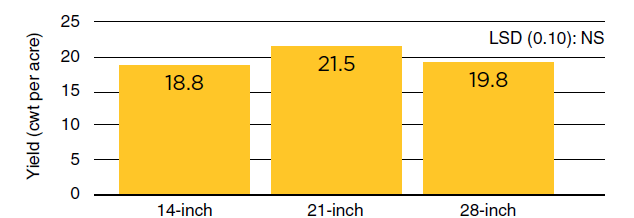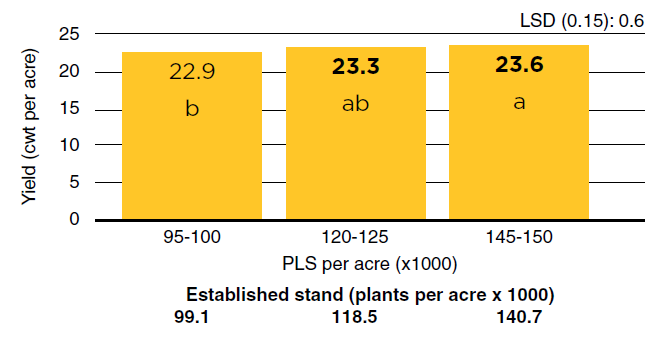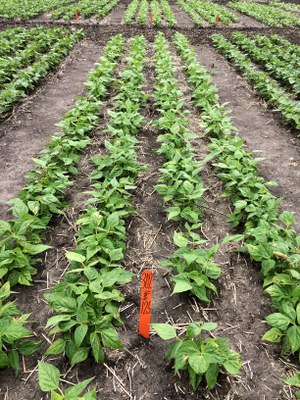Black and Navy Bean Response to Row Spacing and Plant Population in Eastern North Dakota (A1921, May 2019)
Availability: Web only
Based on historic North Dakota work, NDSU recommends an established stand of 90,000 plants per acre for black and navy bean. Research conducted in 1999 to 2000 indicated no seed yield response among black and navy bean planting rates of 90,000, 105,000 and 120,000 pure live seeds (PLS) per acre and a yield increase in one of two years with
7- versus 30-inch row spacings (Schatz et al. 2000).
This publication summarizes NDSU research trials conducted 2014 to 2018 in eastern North Dakota to evaluate potential yield increase of black and navy bean with higher plant populations and narrower rows compared to the traditionally recommended plant density in wide rows.
Materials and Methods
Experimental design: Randomized complete block with four replications at all locations. Carrington: split-plot arrangement with main plot of row spacing and sub-plot of plant populations; Park River and Prosper: factorial arrangement of market class and plant population.
Treatments: ‘Eclipse’ black and ‘Avalanche’ navy bean were planted in 14-, 21- and 28-inch rows at 100,000, 125,000 and 150,000 PLS per acre for a targeted population of 90,000, 110,000 and 130,000 plants per acre, respectively, at Carrington in 2014 to 2017. The research continued with black bean in 2018 with slightly lower planting rates. In addition, the two dry bean market classes were planted at the three planting rates at Park River in 2014 and Prosper in 2014 to 2017 in intermediate row spacing (either 14 or 18 inches).
General: The dryland trials were conducted using conventional-tillage systems on Heimdal-Emrick loam soil at Carrington, Fairdale silt loam soil at Park River and Kindred-Bearden fine-silty loam soil at Prosper. Dry bean was planted generally during the last half of May. Plant populations were measured two to four weeks after planting at Carrington and prior to harvest at Park River and Prosper. After seed maturity, plants were hand-pulled and threshed with a plot combine during the first half of September. Best management practices were used for dry bean production.
Results
Black bean seed yield was not statistically different with the two-factor (row spacing by population) interaction. Averaged across four years and plant populations at Carrington, black bean yield was statistically similar among row spacings (Figure 1). Plant emergence, flowering and physiological maturity dates generally were similar with row spacing each year of the study (data not shown). Canopy closure visually evaluated during late July to early August and averaged over three years was 85%, 76% and 64% with 14-, 21- and 28-inch rows, respectively. Test weight and seed size generally were similar among row spacings (data not shown).
Figure 1. Black bean seed yield among row spacings (inches), Carrington, 2014 and 2016-18 (4 site-years)1.

1 'Eclipse'. Averaged across three plant populations.
Averaged across eight site-years, black bean planted at the low, medium and high rates produced 99,100, 118,500 and 140,700 plants per acre, respectively (Figure 2). Yield increased 3% with the high- versus low-plant population. The intermediate plant population was statistically similar to the high plant population. Plant emergence, flowering and physiological maturity dates generally were similar with plant population (data not shown). Canopy closure, averaged across five site-years, generally was similar among plant populations. Also, test weight and seed size were similar with plant population at each of the eight site-years of the study.
Figure 2. Black bean seed yield among plant populations, Carrington, Park River and Prosper, 2014 and 2016-18 (8 site-years)1.

1 'Eclipse'. Averaged across row spacings.
Navy bean seed yield, averaged across three site-years at Carrington, was statistically different with the two-factor interaction (Table 1). Averaged across three years and rows, plant population was 92,600, 116,800 and 139,800 plants per acre with the low to high planting rates, respectively. Highest yield was achieved at 2,660 and 2,790 lb. per acre with narrow (14-inch) rows plus the medium and high plant populations, respectively. With the range of increased plant populations in this study to maximize yield, targeted populations would need to be determined based on seed costs and market price.
Navy bean plant emergence, flowering date and physiological maturity generally were similar with row spacing and plant population each year of the study at Carrington (data not shown). Canopy closure, averaged over two years, was 91%, 76% and 70% with 14-, 21- and 28-inch rows, respectively. Also, canopy closure was similar among plant populations (data not shown). Test weight and seed size were similar with row spacing and plant population each year of study.
Table 1. Navy bean seed yield among row spacings and plant populations, Carrington, 2014 and 2016-17 (3 site-years).
| Plant population | |||
| Row spacing | 92,600 | 116,800 | 139,800 |
| Inches | Seed yield (lb. per acre) | ||
| 14 | 2580bc | 2660ab | 2790a |
| 21 | 2470cd | 2340d | 2340d |
| 28 | 2010e | 2070e | 2120e |
| LSD (0.10) | - - - - - - - - - - 180 - - - - - - - - - - | ||
Summary
Black bean seed yield was similar among the three row spacings. The high plant population (slightly more than 140,000 plants per acre) increased yield 3% compared to the low population (slightly less than 100,000 plants per acre).
Narrow (14-inch) rows with navy bean plant populations of greater than 115,000 plants per acre increased yield 24% to 28% compared to wide rows with slightly more than 90,000 plants per acre.
References
Knodel, J.J., P.B. Beauzay, G.J. Endres, D.W. Franzen, J. Ikley, H.J. Kandel, S.G. Markell, J.M. Osorno, and J.S. Pasche. 2018 Dry bean grower survey of production, pest problems and pesticide use in Minnesota and North Dakota. NDSU Extension publication E1902. March 2019.
Schatz, B.G., S.F. Zwinger, and G.J. Endres. 2000. Dry edible bean performance as influenced by plant density. NDSU Carrington Research Extension Center. Crop and Livestock Review. Vol. 41, p. 9.
The Northarvest Bean Growers Association supported this research.
NDSU Extension does not endorse commercial products or companies even though reference may be made to tradenames, trademarks or service names.


